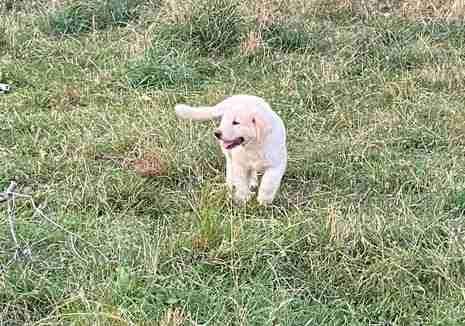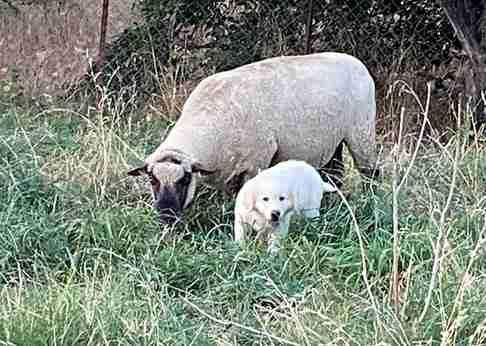By Dan Macon and Carolyn Whitesell
Livestock producers from Southern Europe to Central Asia have long used livestock guardian dogs (LGDs) to protect livestock - including cattle - from predators like wolves and European brown bears (the continental version of our grizzly). Here in the United States, sheep and goat producers have been using these dogs for nearly half a century with good success. U.S. cattle producers, on the other hand, don't have much experience with LGDs. But with the return of state-endangered gray wolves to California (three packs are currently established and transient wolves periodically move through), interest in non-lethal livestock protection tools - including LGDs - is growing amongst cattle producers.
Along with several of my UCCE colleagues, I received a small grant from the Rustici Rangeland and Cattle Endowment at UC Davis to demonstrate how to bond a LGD with cattle. Earlier this month, Likely Land and Livestock in Modoc County offered to collaborate with us - and this week, we found a pup! Next week, I'll deliver the dog and all of the necessary bonding "equipment" to Likely!
The bonding process is critical to the success of any LGD. When pups are 8-20 weeks of age, their brains are especially receptive to forming social bonds - if you've had a pet dog, you'll know that this period is when we try to socialize the pup by exposing it to all sorts of situations and people. With a LGD pup, this period is crucial for creating a bond between dog and livestock. Having used LGDs in my own sheep operation for 15 years, I seem to learn something new every time I start a pup.
Part of this bonding process involves my own behavior. I'm a sucker for puppies, so it takes a real effort on my part not to over-socialize with these cute white fuzzballs. Since these dogs need to spend their lives living with and protecting livestock, we need them to prefer the company of livestock to humans. And my early interactions with a pup are an important part of this process. I should be a source of food and health care, but not the kind of affection we typically show to a puppy - in other words, I need to be somewhat aloof.
Bonding also requires the right kind of physical set up. I want to create an environment where the pup has to interact with livestock. While a successfully bonded dog won't want to escape, a young puppy naturally wants to respond to all external stimuli. Since we use electro-net fencing with our sheep, I usually put the pup with a handful of mature sheep (ewes or rams) inside of electric fence. Typically, the pup learns quickly that the fence has a pop to it - and that life is good when it stays close to the sheep (who already know about the fence).
On Wednesday, my colleague Carolyn Whitesell, the human-wildlife interactions advisor with UCCE in the Bay Area, picked up our pup from a goat producer near Tracy. Since we couldn't get to Likely until next week, we decided to put the pup with a handful of rams at my home place - the pup had been reared with goats, so we thought the rams would be a good option.
As soon as the puppy was left with the rams, he promptly decided that he could get through the bottom section of the electro-net - even though he got shocked. But imagine all of this from the pup's point of view. In one day, he was separated from his siblings and mother, had his first experience in a dog crate and in a moving vehicle, only to arrive at another farm where there were sheep, chickens, horses, mules, and other dogs. I suspect he was a little overwhelmed! We needed to get a little creative.
While all of this was happening, I was on the east side of the Sierra crest, collecting data for another project. Sami came up with a potential solution—why not put up some electrified poultry netting (which has a smaller grid pattern) along the section of electro-net fencing where the pup had been escaping? She put the puppy in our kennel while she set up the poultry netting and then placed the puppy back with the rams. Problem solved! Even though he could have still scooted through other sections of the paddock fence, he now thought he had to stay with the rams. And stay he did!
By the time I got home that evening, the pup had decided he liked the rams. I watched him lick their faces and roll onto his back in front of them (signs of appropriate submissiveness). The next morning, at feeding time, he decided he needed to be in the scrum at the hay bunk (signs of appropriate attentiveness).
The next test will be to take the poultry netting down and make sure he'd still prefer to be with his livestock even without this physical barrier. If he passes this test, I'll be comfortable putting him with calves inside an electro-net paddock next week! Stay tuned!


Source : ucanr.edu